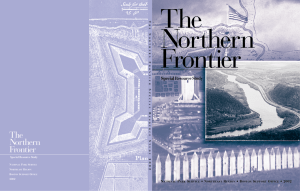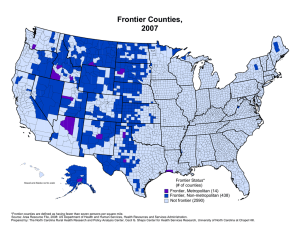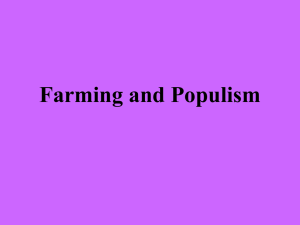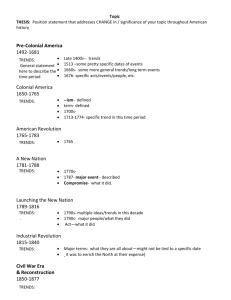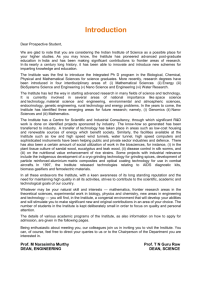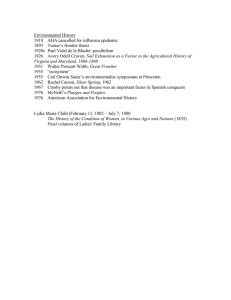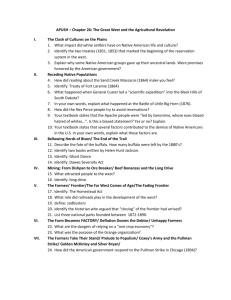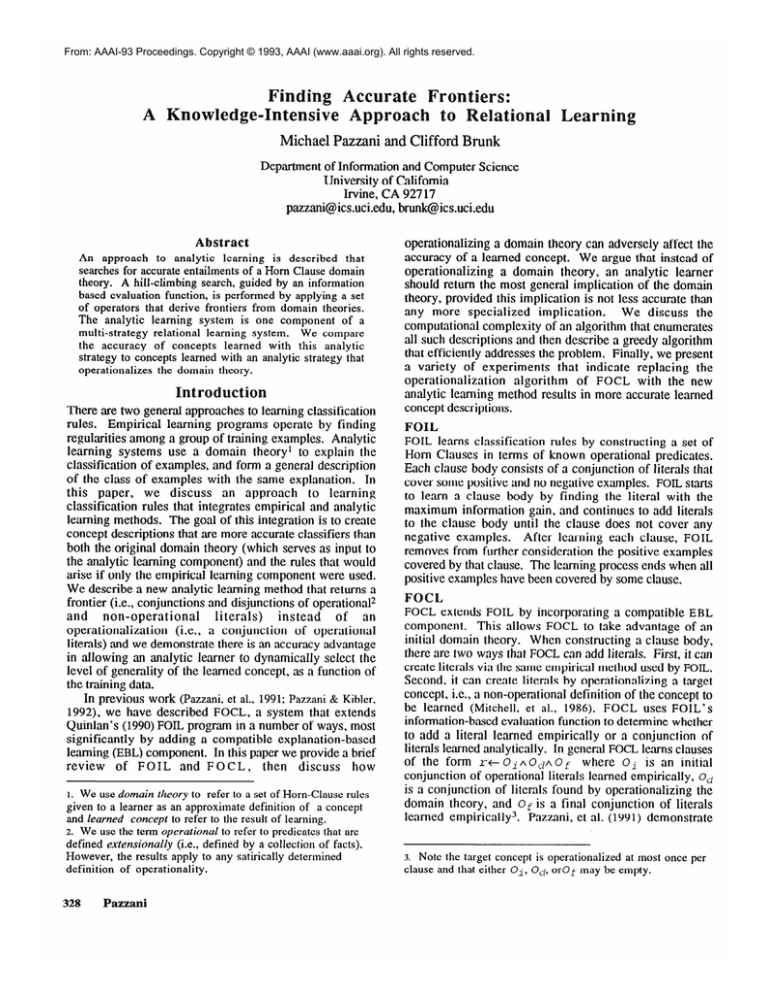
From: AAAI-93 Proceedings. Copyright © 1993, AAAI (www.aaai.org). All rights reserved.
Finding
A Knowledge-Intensive
Accurate
Fro
Michael Pazzani and Clifford Brunk
Department
of Information and Computer Science
University of California
Irvine, CA 92717
pazzani@ics.uci.edu,
brunk@ics.uci.edu
Abstract
An approach
to analytic
learning
is described
that
searches for accurate entailments of a Horn Clause domain
theory. A hill-climbing search, guided by an information
based evaluation function, is performed by applying a set
of operators that derive frontiers from domain theories.
The analytic learning system is one component
of a
multi-strategy
relational learning system.
We compare
the accuracy
of concepts
learned with this analytic
strategy to concepts learned with an analytic strategy that
operationalizes
the domain theory.
Introduction
There are two general approaches to learning classification
rules,
Empirical learning programs operate by finding
regularities among a group of training examples. Analytic
learning systems use a domain theory’ to explain the
classification of examples, and form a general description
of the class of examples with the same explanation.
In
we discuss
an approach
to learning
this paper,
classification
rules that integrates empirical and analytic
learning methods. The goal of this integration is to create
concept descriptions that are more accurate classifiers than
both the original domain theory (which serves as input to
the analytic learning component) and the rules that would
arise if only the empirical learning component were used.
We describe a new analytic learning method that returns a
frontier (i.e., conjunctions and disjunctions of operational2
literals)
instead
of
an
and
non-operational
of operational
operationalization
(i.e., a conjunction
literals) and we demonstrate there is an accuracy advantage
in allowing an analytic learner to dynamically
select the
level of generality of the learned concept, as a function of
the training data.
In previous work (Pazzani, et al., 1991; Pazzani & Kibler,
1992), we have described FOCL, a system that extends
Quinlan’s (1990) FOIL program in a number of ways, most
significantly
by adding a compatible explanation-based
learning (EBL) component. In this paper we provide a brief
review
of FOIL
and F OCL , then
discuss
how
1. We use domain theory to refer to a set of Horn-Clause rules
given to a learner as an approximate definition of a concept
and learned concept to refer to the result of learning.
2. We use the term operational to refer to predicates that are
defined extensionally (i.e., defined by a collection of facts).
However, the results apply to any satirically determined
definition of operationality.
328
Pazzani
operationalizing
a domain theory can adversely affect the
accuracy of a learned concept. We argue that instead of
operationalizing
a domain theory, an analytic learner
should return the most general implication of the domain
theory, provided this implication is not less accurate than
any more specialized
implication.
We discuss the
computational complexity of an algorithm that enumerates
all such descriptions and then describe a greedy algorithm
that efficiently addresses the problem. Finally, we present
a variety of experiments
that indicate replacing
the
operationalization
algorithm
of FOCL with the new
analytic learning method results in more accurate learned
concept descriptions.
FOIL
le‘arns classification
rules by constructing
a set of
Horn Clauses in terms of known operational predicates.
Each clause body consists of a conjunction of literals that
cover some positive and no negative examples. FOIL starts
to learn a clause body by finding the literal with the
maximum information gain, and continues to add literals
to the clause body until the clause does not cover any
negative examples.
After learning each clause, FOIL
removes from further consideration the positive examples
covered by that clause. The learning process ends when all
positive examples have been covered by some clause.
FOIL
FOCL
FOCL extends
FOIL by incorporating
a compatible EBL
component.
This allows FOCL to take advantage of an
initial domain theory. When constructing a clause body,
there are two ways that FOCL can add literals. First, it can
create literals via the same empirical method used by FOIL.
Second, it can create literals by operationalizing
a target
concept, i.e., a non-operational
definition of the concept to
be learned (Mitchell, et al., 1986). FOCL uses FOIL’s
information-b,ased evaluation function to determine whether
to add a literal learned empirically
or a conjunction
of
literals learned analytically.
In general FOCL learns clauses
of the form Z-C OiAOd/\ Of where Oi is an initial
conjunction of operational literals learned empirically, od
is a conjunction
of literals found by operationalizing
the
domain theory, and Of is a final conjunction
of literals
learned empirically 3. Pazzani, et al. (1991) demonstrate
3. Note the target concept is operationalized at most once per
clause and that either Oi, Od, orOf may be empty.
that FOCL can utilize incomplete and incorrect domain
theories. We attribute this capability to its uniform use of
an evaluation function to decihe whether to include literals
learned empirically or analytically.
Qperationalization in FOCL differs from that of most
EBL programs in that it uses a set of positive and negative
examples, rather than a single positive example. A nonoperational literal is operationalized by producing a
specialization of a domain theory that is a conjunction of
operational literals. When there are several ways of
operationalizing
a literal (i.e., there are multiple,
disjunctive clauses), the information gain metric is used to
determine which clause should be used by computing the
number of examples covered by each clause. Figure 1
displays a typical domain theory with an operationalization
( fAghr\kdApAq)
represented as bold nodes.
m
Figure
1. The bold
nodes
represent
one
operationalization
( f ACJAhAkA lApA
) of the domain
theory. In standard EBL, this path would be chosen if it
were a proof of a single positive example. In FOCL, this
path would be taken if the choice made at a disjunctive
node had greater information gain (with respect to a set of
positive and negative examples) than alternative choices.
Operationalization
The operationalization process yields a specialization of the
target concept. Indeed, several systems designed to deal
with overly general theories rely on the operationalization
process to specialize domain theories (Flann & Dietterich,
1990; Cohen, 1992).
However, fully operationalizing a
domain theory can result in several problems:
1. Overspecialization of correct non-operational concepts.
For example, if the domain theory in Figure 1 is
completely correct, then a correct operational definition
will consist of eight clauses. However, if there are few
examples, or some combinations of operationalizations
are rare, then there may not be a positive example
to all combinations
of all
corresponding
operationalizations of non-operational predicates. As a
consequence, the learned concept may not include some
combinations
of operational
predicates
(e.g.,
iAjAkAlArASAt),
although there iS no evidence that
these specializations &areincorrect.
2. Replication of empirical le‘arning. If there is a literal
omitted from a clause of a non-operational predicate,
then this literal will be omitted from each
operationalization
involving this predicate.
For
example, if the domain theory in Figure 1 erroneously
contained the rule bt fAh instead of btfAgAh,
then
each operationalization of Ihe target concept using this
predicate (i.e., fAhAkAlAmAnA0,
fAhAkAlApAq,
and
fAhAkAlArAsAt)
will contain the same omission.
FOCL can recover from this error if its empirical
component can find the omitted literal, g. However, to
obtain a correct learned concept description, FOCL
would have to find the same condition independently
three times on three different sets of examples. This
replication of empirical learning is analogous to the
replicated subtree problem in decision trees (Pagallo &
Haussler,
1990).
This problem should be most
noticeable when there are few training examples. Under
this circumstance, it is unlikely that empirical learning
on several arbitrary partitions of a data set will be as
accurate as learning from the larger data set.
3 . Proofs involving incorrect non-operational predicates
may be ignored. If the definition of a non-operational
predicate (e.g., c in Figure 1) is not true of any positive
example, then the analytic learner will not return any
operationalization using this predicate. This reduces the
usefulness of the domain theory for an analytic learner.
For example, if (=is not true of any positive example,
then FOCL as previously described can find only two
operationalizations: UAV and WAX. Again, we anticipate
that this problem will be most severe when there are
few training examples. With many examples, the
empirical learner can produce accurate clauses that
mitigate this problem.
Figun-e 2. The bold nodes represent one frontier of the
domain theory, bh ( ( IMAO ) v (PAN ) ) .
frontiers
of
a
onmain
eory
To address the problems raised in the previous section, we
propose an analytic learner that does not necessarily fully
operationalize target concepts. Instead, the learner returns a
jkorztier of the domain theory. A frontier differs from an
operationalization of a domain theory in three ways. The
frontier represented by those nodes immediately above the
line in Figure 2, bA ( (mAIlA ) v (DA{? ) ) , illustrates these
differences:
1. Non-operational predicates (e.g., 1~~)
can appear in the
frontier.
Machine Learning
329
2. A disjunction of two or more clauses that define a nonoperational predicate (e.g., (mAnA I v (pr\q) ) can appear
in the frontier.
3. A frontier does not necessarily include all literals in a
conjunction (e.g., neither C, nor any specialization of C,
appears in the frontier).
Combined, the first two distinguishing features of a
frontier address the first two problems associated with
operationalization.
Overspecialization of correct nonoperational concepts can be avoided if the analytic
component returns a more general concept description.
Similarly, replication of empirical learning can be avoided
if the analytic component returns a frontier more general
than an operationalization.
For example, if the domain
theory in Figure 2 erroneously contained the rule be-f Ah
instead of b+fAg/\h and frontier fhhr\kAlr\d was returned,
then an empirical learner would only need to be invoked
once to specialize this conjunction by adding g. Of course,
if one of the clauses defining d were incorrect, it would
make sense to specialize d. However, operationalization is
not the only means of specialization. For example, if the
analytic learner returned fAhAkAlA
( (mAnA0)
v(pAq)
) ,
then replication of induction problem could also be
avoided. This would be desirable if the clause d+rAsAt
were incorrect.
The third problem with operationalization can be
addressed by removing some literals from a conjunction.
For example, if no positive examples use atbAcAd
because c is not true of any positive example, then the
analytic learner might want to consider ignoring c and
trying a+bAd.
This would allow potentially useful parts
of the domain theory (e.g. b and d) to be used by the
analytic learner, even though they may be conjoined with
incorrect parts.
The notion of a frontier has been used before in analytic
learning. However, the previous work has assumed that
the domain theory is correct and has focused on increasing
the utility of learned concepts (Hirsh, 1988; Keller, 1988;
Segre, 1987) or learning from intractable domain theories
(Braverman & Russell, 1988). Here, we do not assume that
the domain theory is correct.
We argue that to increase the accuracy of learned
concepts, an analytic learner should have the ability to
select the generality of a frontier derived from a domain
theory. To validate our hypothesis, we will replace the
operationalization procedure in FOCL with an analytic
learner that returns a frontier. In order to avoid confusion
with FOCL, we use the name FOCL-FRONTIER
to refer to
the system that combines this new analytic learner with an
empirical learning component based on FOIL. In general,
FOCL-FRONTIER learns clauses of the form r+--O~Q’~~Of
where Oi is an initial conjunction of operational literals
learned empirically, Fd is a frontier of the domain theory,
and Of is a final conjunction of literals learned empirically.
We anticipate that due to its use of a frontier rather th‘anan
operationalization, FOCL-FRONTIERwill be more accurate
than FOCL, particularly when there are few training
examples or the domain theory is very accurate.
330
Pazzani
Enumerating Frontiers of a
Formally, a frontier can be defined as follows. Let b
represent a conjunction of literals and p represent a single
literal.
1. The target concept is a frontier.
2. A new frontier can be formed from an existing frontier
by replacing a literal p with blv...vbiv...vb,
provided
there are rules ptbl,...,p+--bi,...,p+-b,.
3. A new frontier can be formed from an existing frontier
by replacing a disjunction blv...vbi_lvbivbi+lV...vbn
with b,v...vbi_lvbi+l
v...vb, for any i. This deletes bi.
4. A new frontier can be formed from an existing frontier
by replacing a conjunction p1A...AP i _ 1 ~p$ AP i+ 1A...AP,
A...AP,
for any i. This deletes pi.
with P~A...AP~_~A~~+~
One approach to analytic learning would be to
enumerate all possible frontiers. The information gain of
each frontier could be computed, and if the frontier with the
maximum information gain has greater information gain
than any literal found empirically, then this frontier would
be added to the clause under construction.
Such an
approach would be impractical for all but the most trivial,
non-recursive domain theories.
Since each frontier
specifies a unique combination of leaf nodes of an and-or
tree (i.e., selecting all leaves of a subtree is equivalent to
selecting the root of the subtree and selecting no leaves of
a subtree is equivalent to deleting the root of a subtree),
there are 2k frontiers of a domain theory that has k nodes
in the and/or tree. For example, if every non-operational
predicate has n clauses, each clause is a conjunction of m
literals, and inference chains have2 $epth of d an&nodes,
then the number of frontiers is 2m n .
Deriving Frontiers from the Target Concept
Due to the intractability of enumerating all possible
frontiers, we propose a heuristic approach based upon hillclimbing search. The frontier is initialized to the target
concept. A set of transformation operators is applied to
the current frontier to create a set of possible frontiers. If
none of the possible frontiers has information gain greater
than that of the current frontiefi, then the current frontier is
returned. Otherwise, the potential frontier with the
maximum information gain becomes the current frontier
and the process of applying transformation operators is
repeated. The following transformation operators are used?
e Clnuse specialization:
If there is a frontier containing a literal P, and there are
exactly n rules of the form ptbl , ... . ptbi, ... . ptb,,
then n frontiers formed by replacing P with bi are
evaluated.
4. The information gain of a frontier is calculated in the same
manner than Quinlan (1990) calculates the information gain of
a literal: by counting the number of positive and negative
examples that meet the conditions represented by the frontier.
5. The numeric restrictions placed upon the applicability of
each operator are for efficiency reasons (i.e., to ensure that
each unique frontier is evaluated only once).
. Specialization by removing disjunctions:
a. If there is a frontier containing a literal p, and there
are n rules of the form ptb, , ... , ptbi ,....pc-b,, then
n frontiers
formed
by replacing
p with
blv...vbi_,vbi+l
v...Vb, are evaluated (provided n>2).
b. If there is a frontier
containing
a disjunction
blv...vbi_lvbivbi+lv...vbm,
then m frontiers
replacing
this
disjunction
with
blV...Vbi_1Vbi+lv...vb,are evaluated (provided m>2).
9 Generalization by adding disjunctions:
If there is a frontier containing
a (possibly trivial)
li terals
disjunction
of
conjunction
of
blv...vbi_lvbi+l
v...vb, and there are rules of the form
..., pt-b, and m<n-1,
ptb, , ... , ptbi_l, ptbi ,Ptbi+l,
then
n-m
frontiers
replacing
the disjunction
v...vb,
blv...vbi_Ivbi+l
v...vb, with blv...vbi_,Vbivb.
are evaluated.
This is implemented
effic&%ly by
keeping a derivation of each frontier, rather than by
searching for frontiers matching this pattern.
* Generalization by literal deletion:
If there is a frontier containing a conjunction of literals
plA~.Api_l~piApi+lA.~Ap,,
then n frontiers replacing
this conjunction
with p 1 A...AP i _ 1 AP i + .,A...AP,
are
evaluated.
There is a close correspondence
between the recursive
definition of a frontier and these transformation operators.
However, there is not a one-to-one correspondence because
we have found empirically
that in some situations it is
advantageous to build a disjunction by adding disjuncts and
in other cases it is advantageous to build a disjunction by
removing disjuncts. The former tends to occur when few
clauses of a predicate are correct while the latter tends to
occur when few clauses are incorrect.
Note that the first three frontier operators derive logical
entailments
from the domain theory while the last does
not. Deleting literals from a conjunction
is a means of
finding an abductive hypothesis. For example, in EITHER
(Ourston & Mooney, 1990), a literal can be assumed to be
true during the proof process of a single example.
One
difference between FOCL-FRONTIER and the abduction
process of EITHER is that EITHER considers all likely
assumptions for each unexplained positive example, and
FOCL-FRONTIER uses a greedy approach to deletion based
on an evaluation of the effect on a set of examples.
Evalluation
In this section, we report on a series of experiments in
which we compare FOCL using empirical learning alone
(EMPIRICAL), FOCL using a combination
of empirical
learning and operationalization,
and FOCL-FRONTIER. We
evaluate the performance
of each algorithm in several
domains. The goal of these experiments is to substantiate
the claim that analytic learning via frontier transformations
results in more accurate learned concept descriptions than
analytic learning via operationalization.
Throughout this
paper, we use an analysis of variance to determine if the
difference in accuracy between algorithms is significant.
1.00
4
0.95
0.90
$ 0.80
0.85
“0 0.75
4 0.70
0.65
0.60
0.55
EMPIRICAL (200)
EMPIRICAL (50)
0
5
10
15
20
25
30
35
FOCL-FRONTIER (200)
FOCL-FRONTIER (50)
0.80
5
10
15
20
25
30
35
Number
of Modifications
Figure 3.
A comparison
of FOCL ‘s empirical
component
(EMPIRICAL), FOCL using both empirical
learning and operationalization, and FOCL-FRONTIER in the
chess end gain domain.
up per: The accuracy
of
EMPIRICAL (given training sets of size 50 and 200) and the
average accuracy of the initial theory as a function of the
number of changes to the domain theory.
Bowes: The
accuracy of FOCL and FOCL-FRONTIER on the same data.
0
Chess End Games
The first problem we investigate
is learning rules that
determine if a chess board containing a white king, white
rook, and black king is in M illegal configuration.
This
problem has been studied using empirical learning systems
by Muggleton, et al. (1989) and Quinlan (1990). Here, we
comp‘are the accuracy of FOCL-FRONTIER and FOCL using
a methodology identical to that used by Pazzani and Kibler
(1992) to compare FOCL and FOIL.
In these experiments the initial theory given to FOCL
and FOCL-FRONTIER was created by introducing either 0,
1, 2, 4, 6, 8, 10, 12, 14, 16, 20, 24, 30 or 36 random
modifications to a correct domain theory that encodes the
relevant rules of chess. Four types of modifications were
made: deleting a literal from a clause, deleting a clause,
adding a literal to a clause, and adding a clause. Added
clauses are constructed with random literals. Each clause
contains at least one literal, there is a 0.5 probability that a
clause will have at least two literals, a 0.25 probability of
containing at least three, and so on.
We ran experiments
using 25, 50, 75, 150, and 200
training examples.
On each trial the training< and test
examples were drawn randomly from the set of 86 possible
board configurations.
We ran 32 trials of each algorithm
and measured
the accuracy
of the learned concept
description on 1000 examples.
For each algorithm the
Machine Learning
331
curves for 50 and 200 training examples are presented.
Figure 3 (upper) graphs the accuracy of the initial theory
and the concept description learned by FOCL’s empirical
component as functions of the number of modifications to
the correct domain theory. Figure 3 (lower) graphs the
accuracy of FOCL and FOCL-FRONTIER.
The following conclusions may be drawn from these
experiment. First, FOCL-FRONTIER is more accurate than
FOCL when there are few training examples. An analysis
of variance indicates that the analytic learning algorithm
has a significant effect on the accuracy (pc.0001) when
there are 25, 50 and 75 training examples. However,
where there are 150 or 200 training examples, there is no
significant difference in accuracy between the analytic
learning algorithms because both analytic learning
algorithms (as well as the empirical algorithm) are very
accurate on this problem with larger numbers of training
examples. Second, the difference in accuracy between
FOCL and FOCL-FRONTIER is greatest when the domain
theory has few errors. With 25 and 50 examples, there is a
significant
interaction
between
the number of
modifications to the domain theory and the algorithm
(p<.OOOland pc.005, respectively).
During these experiments, we also recorded the amount
of work EMPIRICAL, FOCL and FOCL-FRONTIER performed
while learning a concept description. Pazzani and Kibler
(1990) argue that the number of times information gain is
computed is a good metric for describing the size of the
search space explored by FOCL. Figure 4 graphs these data
as a function of the number of modifications to the domain
theory for learning with 50 training examples.
FOCL-FRONTIER tests only a small percentage of the 225
frontiers of this domain theory with 25 leaf nodes. The
frontier approach requires less work than operationalization
until the domain theory is fairly inaccurate. This occurs,
in spite of the larger branching factor because the frontier
approach generates more general concepts with fewer
clauses than those created by operationalization (see Table
1). When the domain theory is very inaccurate, FOCL and
FOCL-FRONTIER
perform slightly more work than
EMPIRICAL because there is a small overhead in
determining that the domain theory has no information
gain.
FOCL (92.6 % accurate)
illegal(WKr,WKf,WRr,WRf,BKr.BKf)tequal(BKf,WRf).
illegal(WKr,WKf,WRr,WRf,BKr,BKf)tequal(BKr,WRrI.
illegal(WKr,WKf,WRr,WRf,BKr,BKf)+near(WKr,BKr)
near(WKf,BKf).
illegal(WKr,WKf,WRr,WRf,BKr.BKf)+-equal(BKr,WKf)
equal(WKr,BKr)
near(WKf,BKf).
illegal(WKr,WKf,WRr,WRf,BKr.BKf)tequal(WKr,WRr)
equal(WKf,WRf).
A
A
A
A
(98.3% accurate)
illegal(WKr,WKf,WRr,WRf,BKr,BKf)tk_attack(WKr,WKf.BKr,BKf)
r_attack(WRr,WRf,BKr,BKf).
V
illegal(WKr,WKf,WRr,WRf,BKr,BKfJ+equal(BKf,WRf).
illegal(WKr,WKf,WRr,WRf,BKr,BKf)tsame_pos(WKr,WKf,WRr,WRf).
Table 1. Typical definitions of i 1 legal. The variables
refer to the rank and file of the white king, white rook, and
the black king. The domain theory was 91.0% accurate
and 50 training examples were used.
Educational
Loans
The second problem studied involves determining if a
student is required to pay back a loan based on enrollment
and employment information. This theory was constructed
by an honors student who had experience processing loans.
This problem, available from the UC Irvine repository,
was previously used by an extension to FOCL that revises
domain theories (Pazzani & Brunk, 1991). The domain
theory is 76.8% accurate on a set of 1000 examples.
We ran 16 trials of FOCL and FOCL-FRONTIER with
this domain theory on randomly selected training sets
ranging from 10 to 100 examples and measured the
accuracy of the learned concept by testing on 200 distinct
test examples. The results indicate that the learning
algorithm has a significant effect on the accuracy of the
learned concept (p<.OOOl). Figure 5 plots the mean
accuracy of the three algorithms as a function of the
number of training examples.
1.00
0.95
*& 0.90
2
0.85
g
0.80
0.65
0
g
9
0
2
x
1000
V
V
500
EMPIRICAL (50)
FOCL (50)
FOCL-FRONTIER (50)
20
30
40
50
60
70
80
90 1OC
Number of examples
Figure 5. The accuracy of FOCL’s empirical component
alone, FOCL with operationalization
and FOCL-FRONTIER
on the student loan data.
Nynex Max
0
0
5
10
15
20
25
30
Number of Modifications
Figure 4: The number of times the information
metric is computed for each algorithm.
332
10
Pazzani
Nynex Max (Rabinowitz, et al., 1991) is an expert system
that is used by NYNEX (the parent company of New York
35
gain
Telephone and New England Telephone) at several sites to
determine the location of a malfunction for customerreported telephone troubles. It can be viewed as solving a
classification problem where the input is data such as the
type of switching equipment, various voltages and
resistances and the output is the location to which a
repairman should be dispatched (e.g., the problem is in the
customer’s equipment, the customer’s wiring, the cable
facilities, or the central office). Nynex Max requires some
customization at each site in which it is installed.
100
200
Number
300
400
of Examples
igure 6. The accuracy of the lea rning al gorithms at
customizing the Max knowledge-base.
In this experiment, we compare the effectiveness of
FOCL-FRONTIERand FOCL at customizing the Nynex Max
knowledge-base. The initial domain theory is taken from
one site, and the training data is the desired output of
Nynex Max at a different site. Figure 6 shows the
accuracy of the learning algorithms (as measured on 200
independent test examples), averaged over 10 runs as a
function
of the number of training
examples.
FOCL-FRONTIER is more accurate than FOCL (p<.OOOl).
This occurs because the initial domain theory is fairly large
(about 75 rules), very disjunctive, and fairly accurate (about
95.4%). Under these circumstances, FOCL requires many
examples to form many operational
rules, while
FOCL-FRONTIER learns fewer, more general rules.
FOCL-FRONTIER is the only algorithm to achieve an
accuracy significantly higher than the initial domain
theory.
elated
ark
Cohen (1990; 1991a) describes the ELGIN systems that
makes use of background knowledge in a way similar to
FOCL-FRONTIER. In particular, one variant of ELGIN
called ANA-EBL, finds concepts in which all but k nodes of
a proof tree are operational. The algorithm, which is
exponential in k, learns more accurate rules from overly
general domain theories than an algorithm that uses only
operational predicates. A different variant of ELGIN, called
K-TIPS, selects k nodes of a proof tree and returns the most
general nodes in the proof tree that are not ancestors of the
selected nodes. This enables the system to learn a set of
clauses containing at most k literals from the proof tree.
Some of the literals may be non-operational and some
subtrees may be deleted from the proof tree. In some
ways, ELGIN is like the optimal algorithm we described
above that enumerates all possible frontiers. A major
difference is that ELGIN does not allow disjunction in
proofs, and for efficiency reasons is restricted to using
small values of k. FOCL-FRONTIER is not restricted in
such a fashion, since it relies on hill-climbing search to
avoid enumerating all possible hypotheses. In addition,
the empirical learning component of FOCL-FRONTIER
allows it to learn from overly specific domain theories in
addition to overly general domain theories.
In the GRENDEL system, Cohen (1991 b) uses a
grammar rather than a domain theory to generate
hypotheses. Cohen shows that this grammar provides an
elegant way to describe the hypothesis space searched by
FOCL. It is possible to encode the domain theory in such a
In addition, it is possible to encode the
grammar.
hypothesis space searched by FOIL in the grammar.
GRENDEL uses a hill-climbing search method similar to
the operationalization process in FOCL to determine which
hypothesis to derive from the grammar. Cohen (1991b)
shows that augmenting GRENDEL with advice to prefer
grammar rules corresponding to the domain theory results
in concepts that are as accurate as those of FOCL (with
operationalization) on the chess end game problem. The
primary difference between GRENDELand FOCL-FRONTIER
is that FOCL-FRONTIER contains operators for deleting
literals from and-nodes and for incorporating several
disjunctions from or-nodes. However, due to the generality
of GRENDEL’sgrammatical approach, it should be possible
to extend GRENDELby writing a preprocessor that converts
a domain theory into a grammar that simulate these
operators. Here, we have shown that these operators result
in increased accuracy, so it is likely that a grammar based
on the operators proposed here would increase GRENDEL’s
accuracy.
FOCL-FRONTIER is in some ways similar to theory
revision systems, like EITHER (Ourston & Mooney, 1990).
However, theory revision systems have an additional goal
of making minimal revisions to a theory, while
FOCL-FRONTIER uses a set of frontiers from the domain
theory (and/or empirical learning) to discriminate positive
from negative examples. EITHER deals with propositional
theories and would not be able to revise any of the
relational theories used in the experiments here. A more
recent theory revision system, FORTE (Richards & Mooney,
1991), is capable of revising relational theories. It has
been tested on one problem on which we have run FOCL,
the illegal chess problem from Pazzani & Kibler (1992).
Richards (1992) reports that with 100 training examples
FOCL is significantly more accurate than FORTE (97.9%
For this problem,
and 95.6% respectively).
FOCL-FRONTIER is 98.5% accurate (averaged over 20
trials). FORTE has a problem with this domain, since it
contains two overly-general
clauses for the same relation
and its revision operators assume that at most one clause is
Although it is not possible to draw a
overly general.
general conclusion
form this single example, it does
indicate that there are techniques for taking advantage of
information contained in a theory that FOCL utilizes that
are not incorporated into FORTE.
Machine Learning
333
Future
Work
Here, we have described one set of general purpose
We are currently
operators that derive frontiers.
experimenting with more special purpose operators
designed to handle commonly occurring problems in
knowledge-based systems. For example, one might wish
to consider operators that negate a literal in a frontier (since
we occasionally omit a not from rules) or that change the
order of arguments to a predicate. Initial experiments
(Pazzani, 1992) with one such operator in FOCL (replacing
one predicate with a related predicate) yielded promising
results.
Gonclusion
In this paper, we have presented an approach to integrating
empirical and analytic learning that differs from previous
approaches in that it uses an information theoretic metric
on a set of training examples to determine the generality of
the concepts derived from the domain theory. Although it
is possible that the hill-climbing se‘arch algorithm will
we have
find a local maximum, experimentally
demonstrated that in situations where there are few training
examples, the domain theory is very accurate, or the
domain theory is highly disjunctive this approach learns
more accurate concept descriptions than either empirical
learning alone or a similar approach that integrates
empirical learning and operationalization. From this we
conclude that there is an advantage in allowing the analytic
learner to select the generality of a frontier derived from a
domain theory both in terms of accuracy and in terms of
the amount of work required to learn a concept description.
Acknowledgments
This research is supported by an Air Force Office of
Scientific Research Grant, F49620-92-J-030, and by the
University of California, Irvine through an allocation of
computer time. We thank Kamal Ali, William Cohen,
Andrea Danyluk, Caroline Ehrlich, Dennis Kibler, Ray
Mooney and Jim Wogulis for comments on an earlier draft
of this paper.
References
Braverman, M. & Russell, S. (1988). Boundaries of
Proceedings of the Fifth International
operationality.
Conference on Machine Learning (pp. 221-233).
Ann Arbor,
MI: Morgan Kaufmann.
Cohen, W. (1990). Explanation-based
generalization as
an abstraction mechanism in concept learning. Technical
Report DCS-TR-271 (Ph.D. dissertation). Rutgers University.
Cohen, W. (1991a). The generality of overgenerality.
Proceedings of the Eighth International Workshop on
Machine Learning (pp. 490-494).
Evanston, IL: Morgan
Kaufmann.
Cohen, W. (1991 b). Grammatically
biased learning:
Learning Horn Theories using an explicit antecedent
description language. AT&T Bell Laboratories Technical
Report 11262-910708-16TM
(available from the author).
334
Pazzani
Cohen, W. (1992). Abductive explanation-based
learning:
A solution to the multiple inconsistent explanation problem.
Machine Learning.
Flann, N., & Dietterich, T. (1990). A study of explanationbased methods for inductive learning. Machine Learning, 4,
187-226.
Hirsh, H. (1988). Reasoning about operationality for
explanation-based
learning. Proceedings of the Fifth
International Conference on Machine Learning (pp. 214220). Ann Arbor, MI: Morgan Kaufmann.
Keller, R. (1988). Operationality and generality in
explanation-based
learning: Separate dimensions or opposite
end-points.
AAAI Spring Symposium on Explanation-Based
Learning.
Stanford University.
Mitchell, T., Keller, R., & Kedar-Cabelli,
S. (1986).
Explanation-based
learning: A unifying view. Machine
Learning, 1, 47-80.
Muggleton, S., Bain, M., Hayes-Michie,
J., & Michie, D.
(1989). An experimental comparison of human and machine
learning formalisms.
Proceedings of the Sixth International
Workshop on Machine Learning (pp. 113-l 18). Ithaca, NY:
Morgan Kaufmann.
Ourston, D., & Mooney, R. (1990). Changing the rules: A
comprehensive
approach to theory refinement.
Proceedings
of the Eighth National Conference on Artificial Intelligence
(pp. 815-820).
Boston, MA: Morgan Kaufmann.
Pagallo, G., & Haussler, D. (1990). Boolean feature
discovery in empirical learning. Machine Learning, 5, 71100.
Pazzani, M., & Brunk, C. (1991). Detecting and correcting
errors in rule-based expert systems: an integration of
empirical and explanation-based
learning. Knowledge
Acquisition,
3, 157-173.
Pazzani, M., Brunk, C., & Silverstein, G. (1991). A
knowledge-intensive
approach to learning relational
concepts.
Proceedings of the Eighth International Workshop
on Machine Learning (pp. 432-436). Evanston, IL: Morgan
Kaufmann.
Pazzani, M., & Kibler, D. (1992). The role of prior
knowledge in inductive learning. Machine Learning.
Pazzani. M., (1992). When Prior Knowledge Hinders
Learning.
AAAI workshop on constraining learning with
prior knowledge. San Jose.
Quinlan, J.R., (1990). Learning logical definitions from
relations.
Machine Learning, 5, 239-266.
Rabinowitz, H., Flamholz, J., Wolin, E.,& Euchner, J.
(1991). Nynex Max: A telephone trouble screening expert
system. In R. Smith & C. Scott (Eds.) Innovative applications
of artificial intelligence,
3, 213-230.
Richards, B. (1992). An Operator-Based
Approach to FirstOrder Theory Revision. Ph.D. Thesis. University of Texas,
Austin.
Richards, B. & Mooney, R. (1991). First-Order Theory
Revision.
Proceedings of the Eight International Workshop
on Machine Learning (pp. 447-451). Evanston, IL: Morgan
Kaufmann.
Segre, A. (1987). On the operationality/generality
tradeoff in explanation-based
learning. Proceedings
of the Tenth
International
Joint Conference
on Artificial Intelligence
(pp.
242-248).
Milan, Italy: Morgan Kaufmann.

